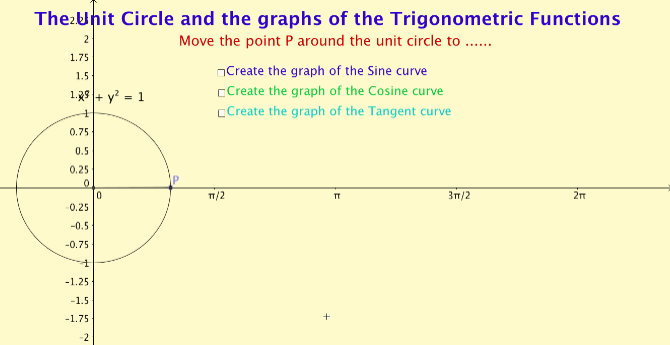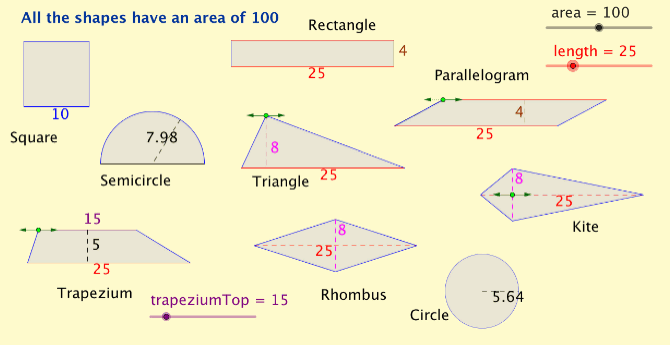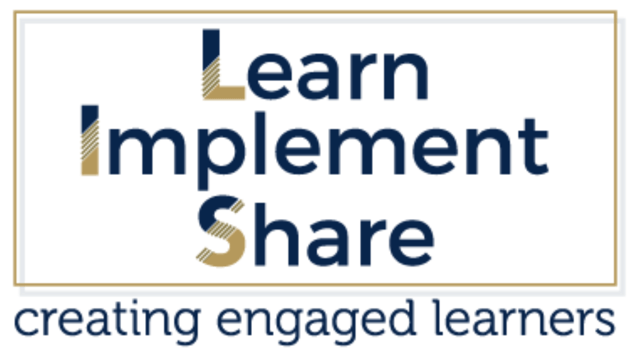Let GeoGebra Transform Your Mathematics Teaching in the Simplest of Ways
(The original GeoGebra file used for the dynamic image above was created by John Dillon, NSW, course participant, September 2009)
Mathematical understanding in schoolsAs mathematics educators, we regularly meet people socially who, upon discovering our vocation, volunteer to us, unasked, their experience of mathematics lessons at school. The general consensus is that 70+ per cent of people struggled with our beloved subject.
Many strategies are available that help students better understand mathematical principles. The challenge is that most of these strategies demand significant pedagogical change, especially for teachers currently using a traditional Procedures-first approach. GeoGebra - A simple solutionAs has been explained here and in the introduction to this article, utilising GeoGebra is a valuable tool for the mathematics classroom, improving engagement and understanding. Using GeoGebra through the plug-in-a-data-projector-and-display-the-file method requires no significant changes for teachers, making it an easy solution for enhancing student learning.
|
Using GeoGebra in the mathematics classroom
GeoGebra offers several ways to engage students in the mathematics classroom:
- 1. Project pre-made GeoGebra files
- 2. Create partially completed files for students to complete and explore
- 3. Encourage students to create and explore their own files as part of an investigation task
This article focuses on the most straightforward method: projecting GeoGebra files. For those interested in student-led investigations, refer to Five tips for designing student-lead GeoGebra investigations.
The dynamic image at the top of this article showcases a GeoGebra file in action. The file, created by John Dillon (a past course participant), is an excellent example of the principles behind the unit circle and trigonometric graphs.
Given we are talking about simply projecting the file as a 2-minute addition to whatever instruction a teacher typically offers, can there be any argument against utilising such a file for a unit segment on trig graphs and the unit circle?
Below is another GeoGebra file, designed by Frederic Jaccard, for younger students. It’s a lovely way to see the relative dimensions of various figures change while keeping the area constant.
The dynamic image at the top of this article showcases a GeoGebra file in action. The file, created by John Dillon (a past course participant), is an excellent example of the principles behind the unit circle and trigonometric graphs.
Given we are talking about simply projecting the file as a 2-minute addition to whatever instruction a teacher typically offers, can there be any argument against utilising such a file for a unit segment on trig graphs and the unit circle?
Below is another GeoGebra file, designed by Frederic Jaccard, for younger students. It’s a lovely way to see the relative dimensions of various figures change while keeping the area constant.
(The original GeoGebra file used for the dynamic image above was created by Frederic Jaccard, Xavier College, NSW, December 2014 course participant)
Why GeoGebra is under-utilised
Despite its potential to improve student engagement and understanding, GeoGebra tends to be superficially used in a great many mathematics classrooms. The main reason is likely due to a lack of awareness of its capabilities; in other words, due to the ‘We don't know what we don't know' factor.
Many teachers only use GeoGebra for upper grades or graphing and geometry, but it can be applied to many topics, including fractions, ratios, trigonometry, statistics, and more.
Yet GeoGebra can be applied to numerous topics, including fractions, ratio and proportion, similarity, number, trigonometry and bearings, statistics, Pythagoras’ Theorem, dynamic explanation of all measurement formulas, and the derivation of pi - to name a few.
Another reason is the lack of user-friendliness of GeoGebra, which can be difficult for teachers to learn on their own, despite the availability of free resources.
This leads to many teachers relying solely on pre-made files, missing out on the opportunity to create conceptually-based files to fit their teaching style, creativity and students.
Many teachers only use GeoGebra for upper grades or graphing and geometry, but it can be applied to many topics, including fractions, ratios, trigonometry, statistics, and more.
Yet GeoGebra can be applied to numerous topics, including fractions, ratio and proportion, similarity, number, trigonometry and bearings, statistics, Pythagoras’ Theorem, dynamic explanation of all measurement formulas, and the derivation of pi - to name a few.
Another reason is the lack of user-friendliness of GeoGebra, which can be difficult for teachers to learn on their own, despite the availability of free resources.
This leads to many teachers relying solely on pre-made files, missing out on the opportunity to create conceptually-based files to fit their teaching style, creativity and students.
I have been inspired to include the use of GeoGebra in my lessons so my students’ learning will be engaging, interactive, collaborative and investigative. This course has taught me so much.
Dianne Ley, Gilroy College, 18.2.15
Comments anyone? We'd love your thoughts below!
NOTE: Create a Hyvor Talk account before commenting (click LOGIN) -that way you'll be notified of replies and you won't be anonymous.
If you don't create an account, please state your name at the start of your comment. Thanks.
NOTE: Create a Hyvor Talk account before commenting (click LOGIN) -that way you'll be notified of replies and you won't be anonymous.
If you don't create an account, please state your name at the start of your comment. Thanks.





